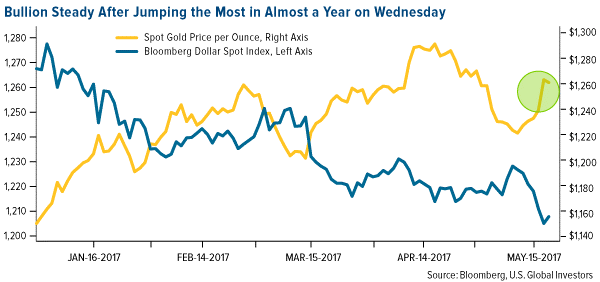Can We Expect Further Weakening Of The US Dollar
Strengths
- The best performing precious metal for the week was silver, climbing 2.36 percent and just beating out gold’s price performance as softer economic data emerged.
- Gold traders and analysts are split on their outlook for gold, reports Bloomberg, with 12 bearish, three bullish and four neutral this week. On May 16 the yellow metal advanced for a fourth day, with Kotak Commodities Services saying gold is supported by “mixed U.S. economic data, weakness in the U.S. dollar, geopolitical tensions and uncertainty about Trump’s policy actions.” On the prior Friday, consumer prices (excluding food and energy) rose 1.9 percent year-over-year for April, the least since 2015, while retail sales were also weaker, reports Bloomberg.
- Eldorado Gold will “gain an operating foothold in its own country with a deal to take full control of Integra Gold Corp,” reports Bloomberg, offering the equivalent of C$1.2125 for each Integra share. That is a 52 percent premium to Integra’s closing price on May 12, according to a statement on Monday from Eldorado. The proposed acquisition provides Eldorado with its first operating mine in Canada, offering G&A and income tax benefits, along with exposure to a lower political risk project, notes a Viii Capital report.
Weaknesses
- The worst performing metal for the week was palladium, down 5.87 percent. UBS noted that electric cars will be brought to the market sooner than consensus expectations and that platinum group metals are expected to lose market demand on this technology adoption.
- Barrick Gold reached an agreement with the Dominican Republic government (where it operates its Pueblo Viejo mine), outlining new financial terms and tax rates, reports Bloomberg. The new terms show the government is projected to receive an additional $181 million from Barrick between 2017 and 2019, according to a statement from the Dominican President’s office. The new terms are based on a gold price of $1,275 per ounce.
- Sibanye Gold Ltd. announced it will sell around $1 billion of shares at a 60-percent discount to partly fund its purchase of Stillwater Mining. The statement soon sent the stock plummeting the most in five months before rebounding after, reports Bloomberg. “The South African miner dropped as much as 11 percent in Johannesburg, the most since December 9, before paring losses to trade 2.4 percent lower,” the article continues.
- Frankfurt-based Commerzbank AG is exiting its physical precious-metals trading and services business, reports Bloomberg. The bank’s physical services include trading of physical precious metals, refining services, vaulting and transportation. Commerzbank does plan to continue its other bullion banking operations.
Opportunities
- Author and investor Mark Faber says that for the first time in a long time he is more heavily weighted in Europe than in the U.S. Faber cites “good opportunities in European stocks” at the present time along with his belief that the euro will continue to strengthen against the dollar. In a Bloomberg phone interview, he continues by stating, “In my opinion in the U.S. they will launch QE4 at the end of the year. The economy in the U.S. is weakening.” He also noted that gold mining shares are “inexpensive” and Amazon is “expensive.”
- Since President Trump’s comments about the dollar being “too strong” back in April, the greenback has since dropped – the Bloomberg Dollar Spot Index has fallen 3.1 percent, reports Bloomberg. Citigroup, the world’s biggest currency trading firm, believes continued erosions for policy changes in D.C. will only lead to further weakening of the currency, the article continues. Even Westpac Banking Corp., the second most-accurate currency forecaster in Bloomberg’s recent rankings, is advising clients to sell the dollar, with Macquarie Bank expecting the greenback to decline as well. Gold traded near a two-week high this week, with equities in retreat “and in

- Bullion markets are staging a tentative recovery, reports Bloomberg, with the number of holes drilled at gold deposits steadily rising for more than a year, according to S&P Global Market Intelligence. For example, exploration has jumped around 50 percent in parts of Argentina for lithium mainly, but also for gold. “When prices fell, exploration budgets were slashed, which means the industry had limited scope to grow,” said Goldcorp CEO David Garofalo. In a similar note from Bloomberg, mining companies lured back to Ecuador after a ban on large projects was overturned, “will welcome news that the incumbent mining minister is set to continue in the role under President-elect Lenin Moreno.”
Threats
- Despite the world’s largest gold-mining companies posting their best profit margins in four years, the biggest ETF linked to producers (the VanEck Vectors Gold Miners ETF) has seen net withdrawals this month of $617 million, reports Bloomberg. During 2016, investors poured record amounts into the ETF, but now it seems the gold rally has faded, with prices lower by 10 percent from 2016 highs. “Some companies are finding it more difficult to tighten their belts further, diminishing prospects for increased cash flow,” the article continues.
- Staff was evacuated and production was suspended at one of the two Banro Corp. gold mines in eastern Democratic Republic of Congo on Thursday, reports Bloomberg. A gunman left three people dead, making this the fourth assault on the company’s operations in eight months. Namoya is the company’s second mine in eastern Congo, beginning production back in January of 2016.
- Acacia Mining will start its three-year process of closing down its Buzwagi mine in Tanzania, reports Bloomberg. According to an emailed statement from the company’s communication manager, the mine will be shut down by 2020, leading to as many as 100 job cuts. At current gold prices, Acacia is not able to increase the life of the mine past the year 2020. Back in March, the Tanzanian government issued a ban on concentrate exports that Acacia said cost the company over $1M a day.






 Frank Holmes is the CEO and Chief Investment Officer of
Frank Holmes is the CEO and Chief Investment Officer of 










